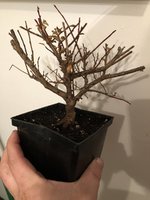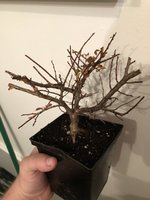Check out Brent's article on Evergreen Gardenworks. He basically suggests letting it grow wild - specifically not removing branches - but still trimming branches about about the width of the pot. This keeps the branches from getting too thick, and probably also helps build some movement and ramification that will come in handy when you decide the trunk is thick enough and its time for branch selection. A bigger pot or in the ground should help.
One thing that is controversial is the effect of not pruning at all while growing a trunk vs keeping the plant in check. The podcast with Dennis Vojtilla discusses this - he likes to trim even on trees that are still developing a trunk. This avoids big scars and unnatural movement. His perspective is that the growth of vascular tissue is based upon foliage not height or length of branches. When I think about this from a physiological perspective, in the fall, deciduous trees gather up their energy for storage in the trunk and roots, putting on vascular tissue. Energy is brought in from the leaves as chlorophyll breaks down, then leaves drop. At this point, you can cut back without sacrificing much in the way of thickening the trunk because the tree isn't going to activate all buds next year, only the apical and some advantageous buds. If you cut back to 2 or 3 buds (or to 1 as Dennis suggests), you get to pick the buds the tree puts energy into, you get more natural growth over time, etc. However, many people feel that if you want to thicken the tree, don't cut it at all (or minimally). I don't know the answer, but I take the route of pruning at least in the fall if not also before summer "dormancy" for more natural movement and because I don't have space to let my trees get lanky.



